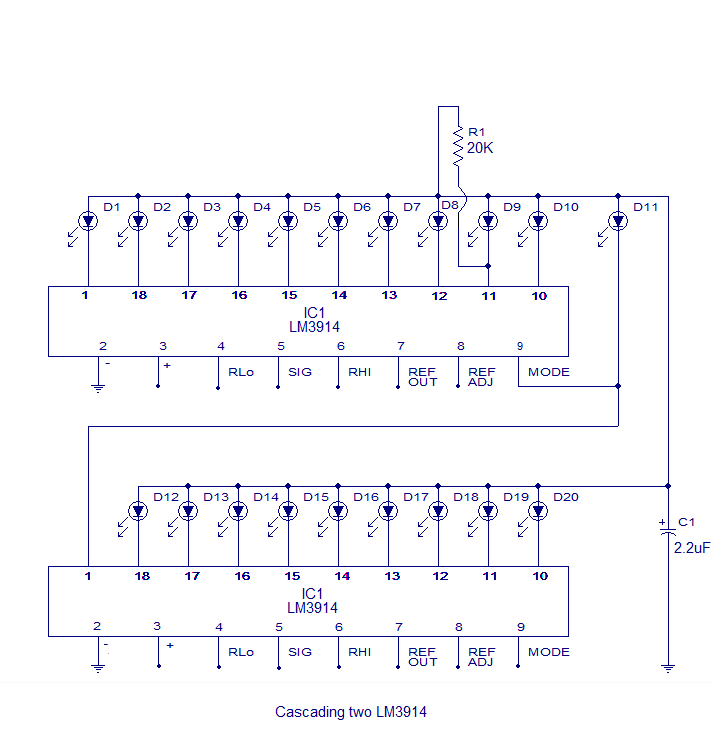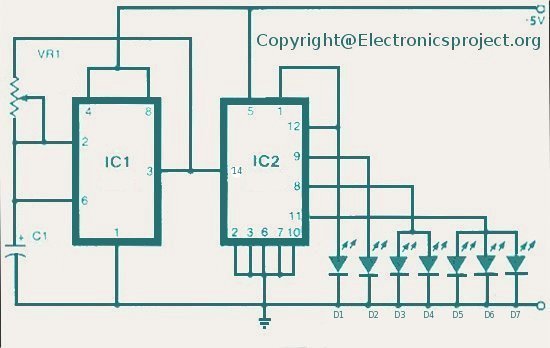
Blinker Indicator

When the lamp turns off, a reset pulse is generated for the corresponding counter by NAND gate IC1. The counter then counts up again. The display's progression rate can be adjusted to the desired speed using potentiometer P1. Only one LED is illuminated at any given time (except for the hazard blinker), which facilitates easy adjustment of brightness using resistor R12. Additionally, the circuit can be modified by substituting standard diodes with LEDs, with all cathodes connected to ground through R12.
The described circuit utilizes a NAND gate (IC1) to manage the reset pulse for a counter mechanism, which is responsible for sequentially illuminating a series of LEDs. The counter increments its count each time the lamp is turned off, triggering a reset that allows the counting process to restart. The adjustment of the display's progression rate is achieved through the use of potentiometer P1, providing flexibility in how quickly the LEDs cycle through their illumination sequence.
The design ensures that only one LED is lit at a time, which serves to enhance visibility and manage power consumption effectively. The exception to this rule is the hazard blinker, which may illuminate multiple LEDs simultaneously for alert purposes. The brightness of the LEDs can be fine-tuned with resistor R12, allowing for user customization based on ambient lighting conditions or personal preference.
Furthermore, the circuit offers versatility in its component selection. By replacing standard diodes with LEDs, the circuit can be adapted to utilize LED technology, which may provide additional benefits such as lower power consumption and longer lifespan. In this modified configuration, the cathodes of the LEDs are connected to ground through resistor R12, maintaining the circuit's operational integrity while enhancing the visual output.
Overall, this circuit design presents a straightforward yet effective approach to managing LED displays, with adjustable parameters that cater to a range of user needs and preferences.When the lamp goes out, a new reset pulse is issued to the relevant counter by NAND gate IC1. A or IC1. B respectively, and the counter counts all the way up again. The progression rate of the display can be adjusted to the right speed using P1. Only one LED is on at a time (except for the hazard blinker). This allows the brightness to be easily adj usted using R12. Incidentally, the circuit can also be modified by replacing the normal diodes with LEDs, with all of the cathodes connected to ground via R12. Be the first of your friends to get free diy electronics projects, circuits diagrams, hacks, mods, gadgets & gizmo automatically each time we publish.
Your email address & privacy are safe with us ! 🔗 External reference
The described circuit utilizes a NAND gate (IC1) to manage the reset pulse for a counter mechanism, which is responsible for sequentially illuminating a series of LEDs. The counter increments its count each time the lamp is turned off, triggering a reset that allows the counting process to restart. The adjustment of the display's progression rate is achieved through the use of potentiometer P1, providing flexibility in how quickly the LEDs cycle through their illumination sequence.
The design ensures that only one LED is lit at a time, which serves to enhance visibility and manage power consumption effectively. The exception to this rule is the hazard blinker, which may illuminate multiple LEDs simultaneously for alert purposes. The brightness of the LEDs can be fine-tuned with resistor R12, allowing for user customization based on ambient lighting conditions or personal preference.
Furthermore, the circuit offers versatility in its component selection. By replacing standard diodes with LEDs, the circuit can be adapted to utilize LED technology, which may provide additional benefits such as lower power consumption and longer lifespan. In this modified configuration, the cathodes of the LEDs are connected to ground through resistor R12, maintaining the circuit's operational integrity while enhancing the visual output.
Overall, this circuit design presents a straightforward yet effective approach to managing LED displays, with adjustable parameters that cater to a range of user needs and preferences.When the lamp goes out, a new reset pulse is issued to the relevant counter by NAND gate IC1. A or IC1. B respectively, and the counter counts all the way up again. The progression rate of the display can be adjusted to the right speed using P1. Only one LED is on at a time (except for the hazard blinker). This allows the brightness to be easily adj usted using R12. Incidentally, the circuit can also be modified by replacing the normal diodes with LEDs, with all of the cathodes connected to ground via R12. Be the first of your friends to get free diy electronics projects, circuits diagrams, hacks, mods, gadgets & gizmo automatically each time we publish.
Your email address & privacy are safe with us ! 🔗 External reference





